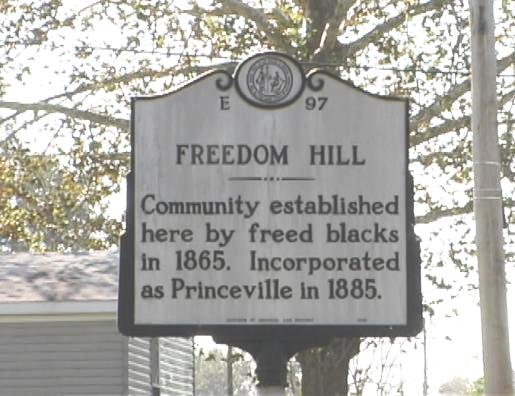Princeville
America's First Black Town and its Battles with Floods

Have you heard of Princeville?
In 1865, a settlement of former slaves who left plantations to join the Union troops was established as Freedom Hill, making it the oldest Black-chartered town in the United States. Since then, it has changed names to Princeville and has been through many challenges. One recurring struggle the community faces to this day is the flooding of the Tar River.
History
Towards the end of the American Civil War, a group of former slaves joined a Union encampment just south of Tarboro near the Tar River. When the war ended and the Emancipation Proclamation1885 was read aloud to the community, they named the settlement “Freedom Hill.” In 1873, a carpenter in Freedom Hill named Turner Prince began purchasing land and building homes on it. In 1885, the community incorporated the settlement and named it after this carpenter, becoming “Princeville.”
Through both Reconstruction and the Jim Crow era, in the face of rising oppression, Princeville remained an independent town that hosted many black-owned businesses. To this day, the town’s residents are predominantly black (90%). They take pride in the town and their ancestors’ resilience.
Flooding
Part of the reason Freedom Hill, and later Princeville, was able to be established and thrive as a community was that it was built on land considered useless by the white-dominant Tarboro residents. This is because of the town’s proximity to the Tar River and its elevation or lack thereof.
Since the community’s establishment after the Civil War, it has flooded nine times. Some of the most notable instances of this flooding have been during powerful hurricanes that affected much of North Carolina.
Princeville experienced severe flooding in September 1999 when Hurricane Floyd swept through. The floods pulled coffins from the cemetery and raised water levels to just below the height of rooftops and church steeples. After Floyd, the federal government proposed turning the historic town into an uninhabited national park and moving its citizens to higher ground. The town ultimately rejected this offer and sought other solutions.
In October 2016, Hurricane Matthew struck the town with similarly devastating results, demolishing half the town.
Because of this frequent flooding and how devastating it has been, the population of Princetown has fluctuated since its founding. Between 1910 and 1923 alone, the population went from 636 to 300.
Mitigation Efforts
In 1967 the U.S. Army Corps of Engineers built a levee in the town to protect it from flooding.
According to a recent article in the Washinton Post, in 2017 Gavin Smith, the director of the Department of Homeland Security’s Coastal Resilience Center of Excellence, organized a five-day design workshop for the town, inviting planners, engineers, and architects from across the country to develop a plan for Princeville that was flood-resilient, safe and welcoming. This included a 53-acre tract of land outside the flood plain where essential services would move.
In 2020, the Army Corps of Engineers announced $39.6 million in funding for a levee project to protect Princeville from future storms.
Currently, the state has funded one existing home to be elevated on stilts, while the Federal Emergency Management Agency (FEMA) committed funds to raise 22 more on concrete blocks.
Looking Forward
In 2018, in collaboration with ECU, NC State, and UNC, Princeville developed the Princeville Community Flood Print Resiliency Plan and the Recovery Plan. The town is currently working to update its zoning ordinances to move forward with these plans and to make sure future building projects are respectful of Princeville’s heritage as well as safe from flooding.
In 2019, Princeville acquired an additional 88 acres adjacent to its 53 acres outside the flood plain to expand and add more amenities to safeguard against future flooding.
In June of 2023, the Army Corps met with Princeville residents to share their findings. Revised modeling showed the new levee would threaten thousands of buildings across the river in Tarboro, as well as upstream and downstream as far as Greenville, so they are unable to complete that project at this time.
There are plans to repair the levee and its four floodgates from the damage that Hurricane Matthew wrought that are scheduled to begin this summer.
Regardless of the many challenges faced both by flooding and other factors, Princeville is a resilient town and its residents are determined to preserve their heritage. I look forward to seeing what new and innovative ways the community finds to mitigate the flood waters and move forward.